
|   |

|   |
An August evening in September - Rajesh Chandrashekaran e-mail: vrontheweb@att.net October 5, 2016 I recently attended an event at the Bharatiya Temple near Philadelphia, organized by a team of dedicated volunteers, as part of a 10 day celebration to honor and invoke the blessings of Lord Ganesha at the time of Chathurthi. The program included a wonderful bouquet of classical dance performances by renowned and dedicated artistes and teachers (from both USA and India) showcasing a rich mix of classical dance forms - Bharatanatyam (Ramya Ramnarayan, Nrityanjali Institute of Dance, NJ), Kathak (Shila Mehta, Nupur Zankar Academy of Performing Arts, Mumbai), and Kuchipudi (Vyjayanthi Kashi and her daughter Prateeksha Kashi, Shambavi School of Dance, Bangalore). 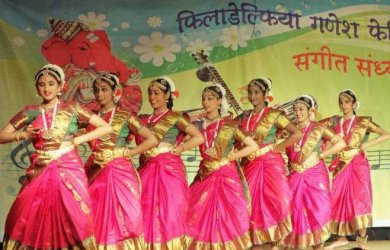 Ramya Ramnarayan’s students The evening opened with two pieces in Bharatanayam by students of Ramya Ramnarayan. The first was Andal Kauthuvam that offered prayer to Sri Ranganatha of Srirangam, followed by an Alarippu in tisra gathi, a vibrant and energetic start to the evening. The coordination among the dancers, and how masterfully and effortlessly they waded their way through complex, intricate formations was impressive. I initially found a spot at the back of the dark hall, but after witnessing some of the enthralling dance sequences, I found myself inching forward, row by row, until I was merely a few rows away from the stage! 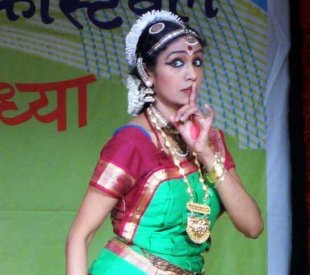 Ramya Ramnarayan The crowded hall fell silent as the lights dimmed and Ramya Ramnarayan took the stage to perform a varnam. Over the next forty odd minutes, Ramya held the audience in rapture as she led us on a journey through Navarasa, the nine states of mind of Goddess Parvathi, to divine music composed by violin maestro Lalgudi G. Jayaraman. Ramya’s skillful execution of the varnam captured the attention of the rasikas. She was able to express a bouquet of emotions, and by the way in which she was able to so swiftly and flawlessly get into and out of an emotive state to move on to yet another was amazing. To see how calm and composed the dancer appeared to be at the end of such a demanding dance was impressive. 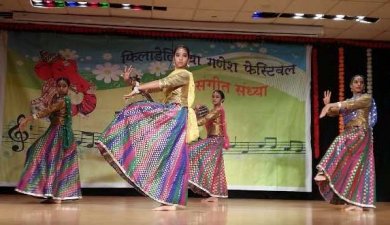 Shila Mehta’s students The next segment of the evening’s performances included several Kathak dances by Shila Mehta and her students. It concluded with an interesting fusion of Bharatanatyam and Kathak by Ramya Ramnarayan and Shila Mehta. This portion of the program opened with a group dance, Natwari Nritta, a pure dance number that was performed in teentaal of 16 beats incorporating Guru Vandana, Toda, Chakradaars, Tihai, Tatkar and Kavit. The dancers, all draped in colourful and flowing costumes, entertained the audience with their lively, rhythmic, and poetic movements. 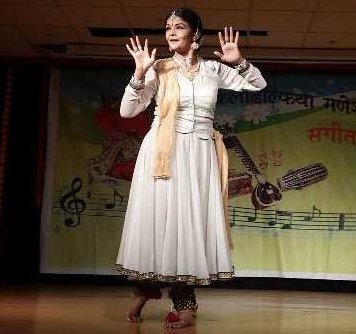 Shila Mehta The group dance was followed by Devi Chandi, a solo by Shila Mehta in which she effortlessly transformed herself into Chandi - a combined form of Lakshmi, Saraswathi and Durga, the ferocious form of Goddess Parvathi. It is said that Chandi is one of the most spectacular of all personifications of cosmic energy - an energy that radiated brilliantly from Shila Mehta as she used elaborate facial expressions combined with amazing body movements to invoke into herself the omnipotent avatar Chandi in all her splendour. Shila Mehta graced the stage once again for another Kathak piece, Chunari, which both vocally and visually depicts the grandeur of the season of Basant, set to chowtaal and ektaal. Yet again, Shila enchanted the audience with her graceful hand and arm movement, coupled with intense footwork. The dancer made good use of space and was also able to make eye contact with the audience, drawing them in, ever so gently, into her own enjoyment. 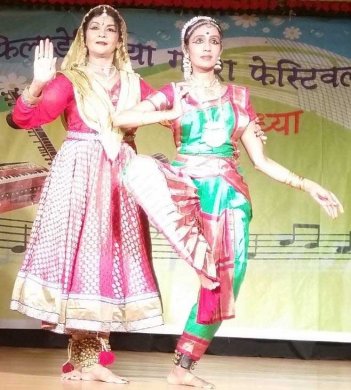 Shila Mehta & Ramya Ramnarayan The Bharatanatyam-Kathak fusion piece by Ramya and Shila was riveting. This sequence was performed to Muthuswami Dikshitar’s delightfully poetic Sanskrit composition ‘Ardanarishwaram’ that glorifies Ardhanarishwara, an amalgam of a male form represented by Shiva and a female form represented by Sakthi. The technically flawless interplay and combined experience and talent of both performers blurred any lines that may have existed between these two distinct styles of dance.  Vyjayanthi Kashi & Prateeksha Kashi The evening culminated with a set of Kuchipudi numbers by mother and daughter duo Vyjayanthi Kashi and Prateeksha Kashi. They offered the audience an impressive array of Kuchipudi sequences, opening with Maha Ganapathy that tells the story of why and how little Ganesha was recruited by the revered sage Vyasa to script the Mahabharata, one of greatest epics ever written. The dance was accompanied by music in praise of Lord Ganesha composed by Muthuswamy Dikshitar. ‘Vande Vande’ was followed by ‘Ardhanareeshwara’, in which one of the dancers depicted Parvathi’s graceful nature as the ultimate representation of all things feminine, while the other skillfully assumed the role of the masculine Shiva performing the tandava. The evening ended with ‘Tarangam-Pahi Pahi,’ a special Kuchipudi number accompanied by music from the well-known Krishnaleela Tarangini by Sage Narayana Theertha that speaks of the life and events of Lord Krishna. The special element of skill that this dance involves is the execution of intricate, rhythmic dance movements while balancing on the rim of a brass plate. The loud and lengthy applause by the audience was proof enough that they were more than impressed by the skill that the dancers exhibited. In all, it was an evening well spent. One appreciates the talent displayed by the dancers – talent that can only come from years of devotion and dedication to the dance form. Dr. Rajesh Chandrashekaran, Ph.D, is a Professor of Marketing at Fairleigh Dickinson University, NJ. His passion includes writing short stories and screenplays; and making short films. |